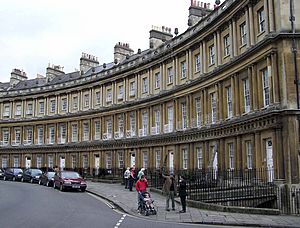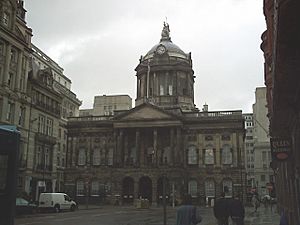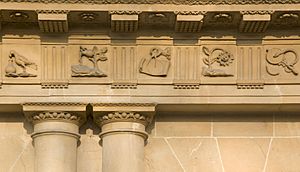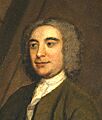John Wood, the Elder facts for kids
Quick facts for kids
John Wood
|
|
|---|---|
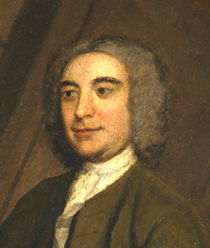 |
|
| Born | 1704 Twerton, England
|
| Died | 23 May 1754 (Aged 49–50) Bath, England
|
| Nationality | English |
| Occupation | Architect |
| Buildings | St John's Hospital, Prior Park, The Royal Mineral Water Hospital |
| Projects | Queen Square, North and South Parades, The Circus |
John Wood, the Elder (born 1704 – died 23 May 1754) was a famous English architect. He is best known for designing many of the beautiful buildings in the city of Bath.
John Wood also studied ancient sites like Stonehenge and the Stanton Drew stone circles. He wrote a lot about old British history and Neo-Druidism. Some of his building designs also suggest he was involved with Freemasonry.
His important projects in Bath include Queen Square, The Circus, and the North and South Parades. He also designed buildings outside Bath, like Liverpool Town Hall. People remember him as one of the best architects of his time.
Contents
Early Life and Beginnings
John Wood was born in Twerton, a small place near Bath. He went to King Edward's School, where he got a good basic education. His father, George, was a builder in the area.
When he was a teenager and in his early twenties, Wood worked for a rich man named Robert Benson. This was at Benson's large estate called Bramham Park in Yorkshire. Later, Wood started building houses in London.
Wood's Vision for Bath
John Wood had big ideas for his hometown of Bath. He learned a lot by reading, visiting other places, and working on projects. He wanted to make Bath a very important and beautiful city again.
By his mid-twenties, Wood combined his love for Palladianism (a classical style of architecture) with his interest in ancient British history. He also seemed to be interested in Freemasonry.
In 1725, he created a grand plan for Bath. However, he faced problems from the city council and landowners. So, he decided to build outside the existing city walls. He worked with Robert Gay, who owned land just outside Bath. On this land, Wood created the unique architectural style that Bath is famous for today.
Wood's work helped make Bath one of the greatest attractions in the world. UNESCO recognizes Bath as a World Heritage Site because it is a beautiful and unified city.
Building New Homes
At Queen Square, Wood started a new way of building in Bath called "speculative building." This meant he leased the land and designed the front of the buildings. Then, he rented out smaller plots to other builders.
These builders had two years to put up the walls and roof. After that, they paid a higher rent. Because Bath was growing fast, most plots were rented out quickly. This helped the builders get money to finish the houses. This method meant less work and risk for Wood, and he made a good profit.
Famous Buildings in Bath
Wood is famous for designing many streets and buildings in Bath. These include St John's Hospital (1727–28), Queen Square (1728–36), and Prior Park (1734–41). He also designed The Royal Mineral Water Hospital (1738–42). Other important works are the North (1740) and South Parades (1743–48), and The Circus (1754–68). Many of these buildings are now protected as Grade I listed buildings.
St John's Hospital was first built around 1180. John Wood, the Elder, helped rebuild it starting in 1727 when he was just 23 years old. This was his first project in Bath.

Queen Square was Wood's first big building project where he rented out plots. Wood himself lived in a house on the square. The north side of the square is especially famous for its beautiful design.
In 1742, Wood built a large home called Prior Park for Ralph Allen, who was the mayor of Bath. This building is on a hill overlooking the city. Since 1830, it has been home to Prior Park College.
The building for the Royal National Hospital for Rheumatic Diseases was also designed by Wood. It was built using Bath Stone given by Ralph Allen. The building has a beautiful pediment (a triangular part above the entrance) that shows a scene from the Bible.
The Circus was Wood's last major project. He died less than three months after construction began, so his son, John Wood, the Younger, finished it. Wood was inspired by the Roman Colosseum. However, unlike the Colosseum, which is meant to be seen from the outside, The Circus faces inwards.
The buildings in The Circus use three classical Orders (Doric, Composite, and Corinthian) stacked one above the other. The decorations on the buildings include symbols of the arts, sciences, and masonic symbols. Wood showed how rows of townhouses could look grand and impressive. His use of similar fronts and balanced designs was copied throughout Bath.
Buildings Outside Bath
John Wood also designed important buildings outside Bath. These include the rebuilding of Llandaff Cathedral (1734–1749), The Exchange, Bristol (1741–43), and Liverpool Town Hall (1749–54).
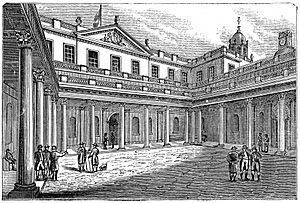
The Exchange, Bristol was built by Wood between 1741 and 1743. It was designed to look like one grand building from the outside. The front has tall Corinthian columns and carvings that represent trade. It is the only 18th-century exchange building in England that still exists today.
Liverpool Town Hall was built from 1749 to 1754, replacing an older building. The ground floor was used for trade, and the upper floor had council rooms. After a fire in 1795, the hall was largely rebuilt.
Studying Ancient Sites
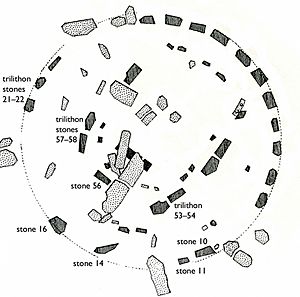
Wood created a very important plan of Stonehenge in 1740. He measured the stones very carefully. This plan is valuable to archaeologists because he recorded the stones before some of them fell down later.
In the same year, Wood also surveyed and mapped the Stanton Drew stone circles. He noted the different stones and thought the layout might be based on an ancient planetary system.
Freemasonry and Symbols
Many of the buildings Wood designed have icons and symbols linked to Freemasonry. This has led many people to believe he was a member of this group, even though there is no official proof. Wood wrote about sacred geometry and believed that the stories of Bath's legendary founder, King Bladud, were true.
Some people suggest that John Wood and his son were connected to Freemasonry through their building work or the symbols in their architecture. For example, when seen from above, The Circus, Queen Square, and Gay Street together form a key shape, which is a Masonic symbol.
Bladud and Ancient Legends
In his writings, Wood described Bladud, a legendary king of the Britons, as the founder of Bath. There is no historical proof that Bladud existed. Wood repeated and added to old stories about Bladud.
The legend says Bladud got leprosy while in Athens. When he returned home, he was imprisoned but escaped. He became a swineherd (someone who looks after pigs) near Bath. He noticed his pigs would go into a muddy area in cold weather and come back covered in warm, black mud. He saw that the pigs who did this didn't have skin problems. He tried the mud bath himself and was cured of his leprosy. After this, he became heir to his father and founded Bath so others could also benefit from the warm springs.
Wood also wrote about Neo-Druidism, which was popular in the 17th and 18th centuries. His studies of Stonehenge and Stanton Drew influenced his work, especially in creating the circular and crescent shapes seen in Bath.
Death and Lasting Impact
John Wood died in Bath on 23 May 1754. He was buried in the churchyard of St Mary's church in Swainswick. Many of his building projects were finished by his son, John Wood, the Younger. This included the famous Royal Crescent, the Bath Assembly Rooms, and The Circus.
Today, Bath is a World Heritage Site. This is largely thanks to the amazing architecture designed by John Wood, the Elder, and his son.
Images for kids



